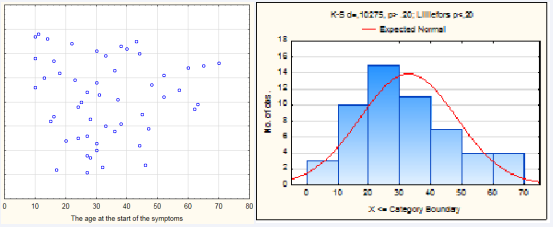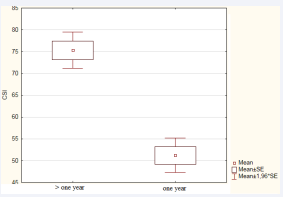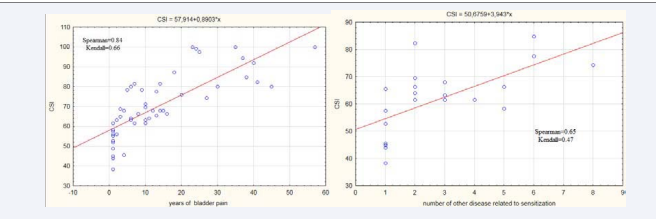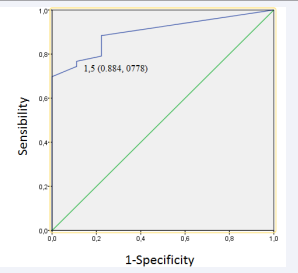Central Sensitization in the Bladder Pain Syndrome
- 1. Department of Neurology and Psychiatry, Sapienza University Rome, Italy
- 2. Multidisciplinary Referral Center of Interstitial Cystitis/Bladder Pain Syndrome, Catholic University, Italy
Abstract
Introduction: Nociceptive hyper-excitability and Central Sensitization (CS), have been identified as responsible for maintaining pain in several chronic neuropathic pain conditions, among which Bladder pain syndrome (BPS). Aim of the present study was to evaluate in patients with BPS the correlation between CS and the following items pain duration, the number of other CS related diseases, the number of tried treatments for pain and of diagnostic investigations before the proper diagnosis and to identify the cut-off value of the pain delays for predicting the worsening of sensitization.
Method: Fifty-eight consecutively BPS outpatients were recruited from 2014 to 2016. They were submitted to Central Sensitization Inventory (CSI), Overactive Bladder Questionnaire (OAB-8v) and visual analogic scale (VAS) for pain. We used a descriptive analysis (mean, standard deviation, range) and Spearman and Kendall test coefficient as correlation index. One-way ANOVA test was used for the comparison between groups. P-value less than 0.05 were required for statistical significance. We used receiver operating characteristic (ROC) curve analysis to retrospectively analyze the association between the years of the disease and pathological values o of CSI.
Results: The patients were observed after 13.1 + 11.0 years by the onset of The CSI score was 69.7+15.8. Resulting significantly lower in patients with BPS onset in the last year the correlation between CSI and the disease duration was significant. The number of previous investigations was 3.7 + 2.8while the number of previous treatments for chronic pain was 5.9 + 3.1, resulting significantly related to CSI score. The OAB-8v was 21 + 7.5 (range 2-34). The worsening of the symptoms related to the overactive bladder at OAB-8v was related to a greater CS. After 1,5 years of the onset of the pain the CS show a progressive worsening.
The mean number of other diseases (fibromyalgia, irritable bowel syndrome, anxiety or depression, migraine, neck injury, Panic Disorder Attack, chronic fatigue syndrome, temporomandibular joint syndrome, restless leg syndrome, multiple chemical sensitivities) associated to CS was 2.8+1.9. The correlation between the number of diseases associated to CS and the years of disease resulted significant.
Conclusion: Patients with long lasting pelvic pain show high levels of CS, and other central sensitivity syndromes (CSS) together to worsening of overactive bladder symptoms, and increasing number of used drugs. The delay of diagnosis is related to a greater sensitization process.
Keywords
• Bladder pain syndrome
• Interstitial cystitis
• Neuropathic pain
• Central sensitization
Citation
Gori MC, Onesti E, Ceccanti M, Cambieri C, Nasta L, et al. (2016) Central Sensitization in the Bladder Pain Syndrome. JSM Pain Manag 1(1): 1004
ABBREVIATIONS
BPS: Bladder Pain Syndrome; CS: Central Sensitization; CSI: Central Sensitization Inventory; OAB-8v: Overactive Bladder Questionnaire; VAS: Visual Analogic Scale; Reuptake Inhibitors, ROC: Receiver Operating Characteristic; DRG: Dorsal Root Ganglion; IBS: Irritable Bowel Syndrome; CSS: Central Sensitivity Syndromes; FM: Fibromyalgia; Anx/Dep: Anxiety Or Depression; MIG: Migraine, NI/W: Neck Injury Or Whiplash; DAP Panic Disorder Attack ; CFS: Chronic Fatigue Syndrome ; TJS: Temporomandibular Joint Syndrome; RLS: Restless Leg Syndrome; MCS: Multiple Chemical Sensitivities
INTRODUCTION
According to the American Urologic Association, the Bladder Pain Syndrome (BPS) is defined as “an unpleasant sensation (pain, pressure, discomfort) perceived to be related to the urinary bladder, associated with lower urinary tract symptoms of more than six weeks duration in the absence of infection or other identifiable causes” [1]. Defects in the glycosaminoglycan layer, with secondary exposure of the submucosal structures to noxious urine components has been demonstrated and considered peripheral pain generators [2]. Bladder hyperalgesia may result from pelvic organ cross sensitization from both peripheral and central mechanisms. Noxious stimuli derived from suffering organ drive afferent information to the dorsal root ganglion (DRG). The convergence at DRG level of neurons arising from adjacent pelvic structures, induce the release of neurotransmitters and peptides in adjacent organs with antidromic propagation. This neurotransmitter release, also called neurogenic inflammation, leads to increased sensitivity in the adjacent organs. Similar to the convergence that occurs in the DRG, convergent neurons from adjacent visceral also occurs in the spinal cord and in the brain for the uterus, urinary bladder and colon [3]. This mechanism of pelvic organ cross sensitization was suggested also as an explanation for co-existing pain in patients with irritable bowel syndrome (IBS) and BPS [3]. Specifically, convergence of afferent input from the urinary bladder and distal colon has been demonstrated in 31% of lateral thalamic neurons [4]. Specific infections were studied as triggered agents for CS in mice [5]. Three main proposed etiologies are bladder urothelial dysfunction, bladder inflammation (possible neurogenic), and neuropathic pain[6].
Recent evidence has found that CS involving an abnormal and intense enhancement of pain by mechanisms in the central nervous system, may be the common link between different disorders, called also central sensitivity syndromes (CSS): BPS, fibromyalgia (FM), chronic fatigue, irritable bowel (IBS), and temporomandibular joint (TMJ) disorders[7,8]. Few studies exist on the characterization of CS in patients with BPS.
Aim of the present study was to evaluate in patients with BPS the correlation between CS and characteristics of pain, the frequency of association with other CS related diseases, the amount of tempted treatments for pain, the number of diagnostic investigations before the correct diagnosis and the cut-off value of the pain delays for predicting the worsening of sensitization.
MATERIALS AND METHODS
Fifty-eight consecutive BPS outpatients were recruited from 2014 to 2016 (4 men and 54 women) in the Rare Neuromuscular Disease Center of Umberto I Hospital in Rome. The diagnosis of BPS was confirmed with urodynamic analysis and cystoscopy chydrodistension in all patients, with evidence of glomerulations or petechial hemorrhages and/or Hunner’s ulcers [9]. The study was approved by the medical ethics committee of the Umberto I Hospital in Rome. The patient records were anonymous and de-identified prior to analysis.
Patients were submitted to the following test: the Central Sensitization Inventory (CSI) and the Overactive Bladder Questionnaire short form (OABq-8v) and the VAS for pain. The CSI is a useful tool, in both general and specialty medical settings, to help identify patients whose presenting medical issues may be co-morbid symptoms of CSS [8]. It consists of two sections, Parts A and B, analyzing Physical Symptoms, Emotional Distress, Headache/Jaw Symptoms, Urological Symptoms. The Part A contains 25 items with total score from 0-100. It provides an overview of presenting symptoms that are common to CSS, with higher scores associated with a higher degree of symptomatic pattern. The Part B identifies how many disorders associated to CSS has been diagnosed by a physician. The factor analysis showed four factors: Physical Symptoms, Emotional Distress, Headache/Jaw Symptoms, Urological Symptoms [10]. In normal subjects, the cutoff of CSS is 28.9 + 13.5 (range 4-55) [10]. In patients with BPS the mean CSS is 55.0 + 17.1[11,12].
The OABq-8v is a widely used test as a screening tool for use in a primary care setting to identify patients who may have OAB-8v and evaluation of OAB-8v treatment outcomes [13]. This questionnaire addresses “patient-reported outcome” such as effect on the patient’s life of symptoms [14] (Coyne KS, 2005).
A visual analogical scale (VAS) for pain assessment was used. We asked the patient to represent graphically her/his intensity of the last week pain on a scale of 0 to 100.
We used a descriptive analysis (mean, standard deviation, range) and Spearman and Kendall test coefficient for correlation index. One-way ANOVA test was used to compare groups. P-value less than 0.05 were required for statistical significance. These data analyses were performed using the PASW statistics base 18.0 software package (SPSS Japan Inc., IBM, Tokyo, Japan) and EXCEL 2010 (Microsoft, Redmond, WA, USA). The ROC curve identifies the time interval elapsing between onset of pain and worsening of sensitization, measured as SCI score > 55 (maximum score in the range of normal subjects)[11]. Sensitivity and specificity of variables were based on receiver operating characteristic (ROC) curve analysis. In a ROC curve the true positive rate (sensitivity) is plotted in function of the false positive rate (100-specificity) for different cut-off points of a parameter. Each point on the ROC curve represents a sensitivity/specificity pair corresponding to a particular decision threshold. The area under the ROC curve is a measure of how well a parameter can distinguish between two groups (successful/unsuccessful).
RESULTS AND DISCUSSION
The main characteristics of the patients and the correlation between the CSI and the other variables are shown in Table (1) and Table (2). The 58 patients had the onset of symptoms at 33.1 (±15.6) years, with the majority of the cases between 10 and 40 years (Figure 1).
Figure 1 The age of the patients at the start of the symptoms
Diagnosis was made after 10.5 (±10.5) years from the onset of symptoms The high standard deviation was because 13 patients (22.5%) received diagnosis in the same year of onset of symptoms. For this reason we compared the CSI in patients with one or more year of pain. CSI resulted significantly lower in patients with BPS in the first year than in patients suffering from more than one year [mean 51.23 + 7.0 in patients with a year of pain vs. 75.3 (+12) in patients with longer duration of disease; F (1; 56) = 35.56; p <0.05)] (Figure 2).
Figure 2 (Comparison between the CSI in patients with a diagnosis of BPS made in the last year, or by more than one year.
The correlation between SCI and the years of bladder pain was significant (r = 0.84 by the Spearman test, p <0.05; r = 0.66 by the Kendall test, p <0.05). The correlation between the number of diseases associated to CS and the years of disease was significant (r = 0.65 by the Spearman test, p <0.05; r = 0.47 by the Kendall test, p <0.05) (Figure 3).
Figure 3 Relation between the years of bladder pain and the CSI score (on the left). Relation between the number of other diseases related to the sensitization and the CSI score (on the right)
The other related CSS diseases were fibromyalgia (FM) (70%), irritable bowel syndrome (IBS) (70%), anxiety or depression (70%), migraine (MIG) (60%), neck injury or whiplash (NI/W) (40%), Panic Disorder Attack (DAP) (30%), chronic fatigue syndrome (CFS) (20%), temporomandibular joint syndrome (TJS) (20%), restless leg syndrome (RLS) (10%), and multiple chemical sensitivities (MCS) (10%) (Figure 3). Only in one patient, the fibromyalgia preceded the onset of bladder symptoms. Also the increased number of the years of bladder pain related to the increase of the other CSS diseases (r = 0.51 by the Spearman test, p <0.05; r = 0.39 by the Kendall test, p <0.05) (Figure 4). The worsening of the symptoms related to the overactive bladder at the OABq-8v was related to a greater CS (r = 0.37 by the Spermann test, p <0.05; r = 0.27 by the Kandell test, p <0.05).
Figure 4 The other diseases after diagnosis of BPS, in the time (on the left) and the type of the diseases (on the right). Legend: fibromyalgia (FM), irritable bowel syndrome (IBS), anxiety or depression (anx/dep), migraine (MIG), neck injury or whiplash (NI/W), Panic Disorder Attack (DAP), chronic fatigue syndrome (CFS), temporomandibular joint syndrome (TJS), restless leg syndrome (RLS), multiple chemical sensitivities (MCS).
The previous pain treatments included amitriptyline, venlafaxine, diazepam, clomipramine, botulinum infiltration, ialuronic acid, pregabalin, gabapentin, sodium valproate, lamotrigine, duloxetine, sertraline, oxycodone associated to naloxone, tapendatol, paracetamol associated to codeine, tramadol, morphine, N-butyl bromide, diclofenac, ketorolac, acetylsalicylic acid, other FANS, steroids, palmitoylethanolamide, fibrase, alfuzosine, hydroxyzine, cimetidine, hyperbaric chamber, acupuncture, sacral neuromodulation, and hypnosis. The number of previous pain treatment resulted related to CSI (r = 0.37 by the Spearman test, p <0.05; r = 0.27 by the Kendall test, p <0.05) (Figure 4).
As logically expected, an increase of the years of pain related to an increase of different tempted strategies to reduce pain. In other words, a higher number of years with pain related to the number of pain treatments (r = 0.32 by the Spearman test, p <0.05; r = 0.24 by the Kendall test, p <0.05) (Figure 5).
Figure 5 The number of tempted therapies for pain in relation to the CSI and in relation to the years of the pain
The area under the curve of CSI was 89.9% (95%CI: 0.812- 0.986) (Figure 6). The optimal cut-off value for the worsening of CS was a score of 1,5 years after the onset of the pain (sensitivity = 0.88; specificity = 0.78). Nine patients of the 13 who had one year of the start of the pain had normal CSI scores, while 4 out of 13 had not normal CSI. Thirty-seven patients out of 45 patients who had a period of pain more than one year had not normal CSI, while 8 patients out of the 45 had normal CSI.
Figure 6 Receiver operating characteristic curve to evaluate the years for the worsening of CS.
The findings of the present study suggest that in patients with BPS, the pain reflects a neuropathic condition underlying a CS process. In patients with BPS, dysfunctional sensory processing in the central nervous system (CNS) may explain the perceived pain. The CS describes an abnormal processing of sensory information.
Patients with BPS often present with several seemingly unrelated symptoms. This can be explained by co-existing chronic pain syndromes occurring in the same patient. Central sensitization occurs in all of these pain syndromes also described as dysfunctional pain syndromes, and thus may explain why several often occur in the same patient [15]. This finding is in line with previous studies showing that chronic nociceptive signals from the bladder to the CNS could lead to increased excitability of T10-T12 spinal convergent neurons, reinforcing the gain of spinal transmission. This is manifested clinically as the development of secondary hyperalgesia and allodynia to the area of referred pain[16]. Our study shows an early onset of BPS symptoms, with the majority of the cases between 10 and 40 years. An earlier diagnosis allows a consistent and appropriate treatment, according to the international guidelines but in our sample the patients with a longer history of pain have also taken the most incongruous treatments in the desperate attempt to resolve the pain. Moreover, the number of tempted treatments is more closely related to the severity of sensitization rather than to the number of years elapsed experiencing pain. The increase of treatment could be due to the emergence of new pathologies, related to the sensitization, over the time. Our patients suffer from widespread pain and manifest signs compatible with CS also agree with previous studies showing that many patients with BPS suffer from widespread pain and hyperalgesia to pain stimuli [9]. Widespread pain might reflect abnormal central processing of the nociceptive input associated with descending modulatory system dysfunction [17]. This finding might be relevant for the pharmacological treatment of pain in this rare disease.
We should like to use a measuring instrument for reporting pain severity over all the time but this measure does not exist, because scales as the VAS refers only to the experienced the previous week. Central Sensitization Inventory (CSI) is a useful tool, in both general and specialty medical settings, to help identify patients whose presenting medical issues may be co-morbid symptoms of CSS. This identification can then help guide the practitioner’s treatment approach[10].
In our sample the diagnosis was performed after an extremely variable time interval from onset of symptoms (from 0 to 37 years). The younger patients had an earlier diagnosis then older patients. This data is partly explained by the fact that over the last years there has been a growing interest in the BPS with the publication of an increased number of researches. In the subgroup of 13 newly diagnosed BPS patients with onset symptoms in the previous year. The clinical history of pain lasted more than 6 months and the CSI was significantly different compared to patients who had more than one year of pain. We can assume that the CS processes are activated in a period of time after onset of symptoms with a progressive worsening over the years. Referring to the reported regression lines of our study, the number of disease increases every year 0.06 and the number of treatment increases every year 0.08. Our mean CSI was higher (69.7+15.8) in comparison with CSI reported in the literature (55.0 + 17.1), related to patients with BPS[8]. Patients who scored in the extreme CSI severity level (CSI 60 to 100) were more likely to report previous diagnoses of fibromyalgia, chronic fatigue syndrome, temporomandibular joint disorder, tension/migraine headaches, and anxiety or panic attacks [11]. Our results show that extreme levels of CSI may occur also in patients with BPS, in the early stage of the disease, with more progressive worsening over the time.
The diagnosis of chronic pain is after 6 months by the onset of the pain and our study showed that after 1,5 years of the onset of the pain the CS show a progressive worsening. Six months represents the time after which the pain becomes chronic and a year and a half represents the time after which the central sensitization mechanism progressively worsens. This is the time for diagnosis and the opportune time to begin an appropriate drug treatment. This implies the need to perform early diagnosis.
Table 1: The correlation between CSI and other variables.
| CSI | |
| Age | 0.22; 0.16 |
| Years of the bladder pain | 0.84* |
| VAS | 0.10; 0.08 |
| Number of other disease related to CS | 0.65*; 0.47* |
| OABq-8v | 0.37* ;0.27* |
| Previous investigations | 0.03;0.01 |
| Previous pain treatment | 0.37* ;0.27* |
| The first number is the result at the Spearman test; the second number is the result at Kendall test* p<0.05 | |
CONCLUSION
Patients with long lasting pelvic pain show increased levels of CS and the progressive development of other CSS over the time. When chronic pain is viewed as a symptom of local diseases and imaging studies, laboratory evaluations, physical exams or surgery interventions do not reveal any etiology, frustration for patients and their providers often ensues. Furthermore, when chronic pelvic pain is recognized as a syndrome or as dysfunction within the central nervous system, the outlook changes. Patients can be given an explanation for their pain, given a diagnosis and education on chronic pain physiology with a sure improvement of their quality of life and decreasing disability.














































































































































